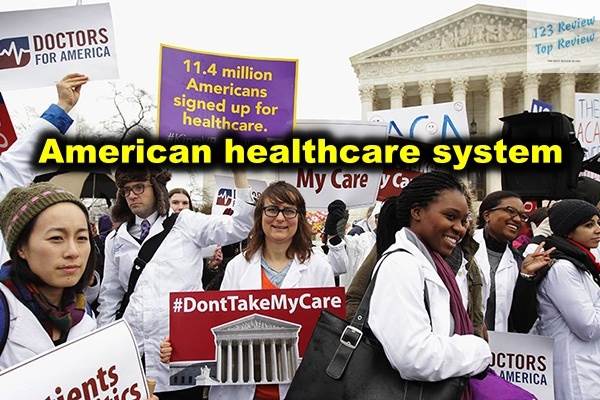The American healthcare system is one of the most complex and contentious systems in the world. It is characterized by a unique blend of public and private sectors, with intricate interactions between government programs, private insurers, healthcare providers, and patients. This system has been the subject of ongoing debate and analysis, particularly in terms of its structure, performance, accessibility, and quality.

In this article, 123 Review seeks to delve into the various aspects of the American healthcare system, providing a detailed assessment of its current structure, performance metrics, quality of care, barriers to optimal healthcare delivery, recent reforms, and future trends.
Current Structure of the American Healthcare System
Primary Components of the Healthcare System
The American healthcare system is composed of several primary components, each playing a distinct role in the delivery of healthcare services. These include:
- Healthcare Providers: This group includes hospitals, clinics, private practices, and long-term care facilities. Hospitals are often categorized as for-profit, non-profit, or government-owned, each with different operating models and financial structures. Clinics and private practices provide outpatient care, focusing on primary and specialized care. Long-term care facilities cater to patients with chronic illnesses or disabilities requiring extended care.
- Health Insurance Entities: Health insurance in the U.S. is provided through a mix of public and private programs. Private insurance companies offer plans through employers or individual markets. Public insurance programs, such as Medicare, Medicaid, and the Children’s Health Insurance Program (CHIP), are funded by the government and serve specific populations, including the elderly, low-income individuals, and children.
- Pharmaceutical Companies and Medical Device Manufacturers: These entities are critical to the healthcare system, providing medications, treatments, and medical devices essential for patient care. The pharmaceutical industry is highly regulated, with agencies like the Food and Drug Administration (FDA) overseeing the approval and monitoring of drugs and devices.
- Government Agencies: Several federal and state agencies regulate and oversee the healthcare system. The Centers for Medicare & Medicaid Services (CMS) administers government insurance programs, while the Department of Health and Human Services (HHS) oversees public health, research, and policy implementation. State health departments play a crucial role in managing public health at the local level.
Types of Health Insurance Coverage
Health insurance in the U.S. is diverse, with several types of coverage catering to different segments of the population:
- Employer-Sponsored Insurance (ESI): This is the most common form of health insurance, covering nearly half of the U.S. population. Employers offer these plans as part of employee benefits, with costs typically shared between the employer and employee. Plans vary widely in terms of coverage, premiums, deductibles, and co-pays.
- Government Programs:
- Medicare: A federal program providing health insurance to individuals aged 65 and older, and to certain younger people with disabilities. Medicare is divided into four parts (A, B, C, and D), covering hospital care, outpatient services, and prescription drugs.
- Medicaid: A joint federal and state program that provides health coverage to low-income individuals and families. Eligibility and benefits vary by state, and the program is a critical safety net for millions of Americans.
- Children’s Health Insurance Program (CHIP): This program offers low-cost health coverage to children in families that earn too much to qualify for Medicaid but cannot afford private insurance.
- Individual Private Insurance: Individuals who are not covered by employer-sponsored plans or government programs can purchase insurance directly from private insurers. These plans are often more expensive and vary in terms of coverage options. The Affordable Care Act (ACA) created health insurance marketplaces to help individuals find and purchase these plans, often with subsidies based on income.
Distribution of Healthcare Services
The distribution of healthcare services across the United States is uneven, influenced by factors such as geography, socioeconomic status, and population density:
- Urban Areas: Cities and metropolitan areas generally have a higher concentration of healthcare facilities, including large hospitals, specialized clinics, and a wide range of healthcare professionals. Urban residents typically have better access to healthcare services, though disparities can exist within cities, particularly in underserved communities.
- Rural Areas: Rural regions often face significant challenges in accessing healthcare. These areas may have fewer hospitals and clinics, and residents often have to travel long distances for care. Rural hospitals are also more likely to face financial difficulties, leading to closures that further exacerbate access issues.
- Healthcare Workforce Distribution: The availability of healthcare professionals, including doctors, nurses, and specialists, is another critical factor in the distribution of services. Rural areas often face shortages of healthcare providers, which can lead to longer wait times and limited access to specialized care. Efforts to address these disparities include loan forgiveness programs for medical professionals who work in underserved areas and the expansion of telemedicine.
Performance Assessment of the American Healthcare System
Healthcare Outcomes Comparison
When assessing the performance of the American healthcare system, it is important to compare healthcare outcomes with those of other developed nations. The U.S. excels in certain areas but falls short in others:
- Strengths: The U.S. leads the world in medical innovation, with cutting-edge treatments and technologies, particularly in specialized areas like cancer treatment, cardiovascular care, and surgical procedures. The country also has some of the best healthcare facilities and research institutions globally, contributing to advances in medical science and improved outcomes in specific diseases.
- Weaknesses: Despite these strengths, the U.S. lags behind other developed nations in key health indicators, such as life expectancy, infant mortality, and chronic disease management. These disparities highlight the uneven distribution of healthcare quality and access, as well as systemic issues such as high healthcare costs and socioeconomic inequalities.
- Comparative Data: According to the Organization for Economic Cooperation and Development (OECD), the U.S. spends more on healthcare per capita than any other country, yet it ranks lower in life expectancy and higher in preventable hospital admissions. These discrepancies suggest that the U.S. healthcare system is not delivering value commensurate with its high costs.
Cost Efficiency and Financial Burden
The financial aspect of the American healthcare system is one of its most criticized features, with high costs being a significant burden on individuals, families, and the economy:
- Healthcare Spending: Healthcare spending in the U.S. is the highest in the world, accounting for nearly 18% of the nation’s GDP. This high expenditure is driven by several factors, including the high cost of medical procedures, pharmaceuticals, administrative expenses, and the prevalence of chronic diseases.
- Financial Burden on Households: Many Americans face significant financial strain due to high out-of-pocket costs, including deductibles, co-pays, and prescription drug prices. Even those with insurance can encounter unexpected medical bills, often leading to financial hardship. Medical debt is a leading cause of bankruptcy in the U.S., highlighting the severe impact of healthcare costs on financial stability.
- Cost Efficiency: Despite the high spending, the U.S. healthcare system is often criticized for its lack of cost efficiency. Administrative costs are particularly high, partly due to the complex and fragmented nature of the system. There is also significant variation in the cost of medical procedures across different regions and providers, contributing to inefficiencies and inequities in care.
Accessibility of Services Across Demographics
Accessibility to healthcare services in the U.S. varies widely across different demographic groups, influenced by factors such as income, race, geography, and insurance status:
- Income Disparities: Low-income individuals and families are more likely to be uninsured or underinsured, limiting their access to healthcare services. Even with Medicaid and other safety-net programs, many low-income Americans struggle to afford necessary care, leading to delayed diagnoses and untreated conditions.
- Racial and Ethnic Disparities: Minority populations, including African Americans, Hispanics, and Native Americans, often face disparities in access to healthcare. These disparities are reflected in higher rates of chronic diseases, lower life expectancy, and poorer overall health outcomes compared to white Americans. Factors contributing to these disparities include systemic racism, cultural barriers, and differences in healthcare coverage and access.
- Geographic Disparities: As mentioned earlier, rural areas face significant challenges in accessing healthcare services due to the lack of facilities and healthcare professionals. These geographic disparities can lead to worse health outcomes for rural residents, including higher rates of preventable diseases and mortality.
Quality of Care Evaluation
Standards and Metrics for Quality Assessment
Evaluating the quality of care in the American healthcare system involves the use of various standards and metrics that measure different aspects of care:
- Patient Safety Indicators: Patient safety is a critical component of healthcare quality. Metrics include rates of hospital-acquired infections, surgical complications, medication errors, and adverse events. Regulatory bodies like the Centers for Medicare & Medicaid Services (CMS) and the Joint Commission monitor these indicators and enforce safety standards.
- Clinical Guidelines and Adherence: Quality of care is also assessed by adherence to established clinical guidelines and best practices. These guidelines are developed based on evidence from clinical research and are designed to ensure that patients receive care that is effective, efficient, and consistent with the latest medical knowledge.
- Health Outcomes: Health outcomes are perhaps the most direct measure of quality. Metrics include survival rates, recovery times, readmission rates, and overall patient health improvement. These outcomes are influenced by the quality of care provided, as well as factors like patient compliance and access to follow-up care.
Patient Satisfaction and Experience
Patient satisfaction is a crucial aspect of healthcare quality, reflecting the patient’s perspective on the care they receive:
- HCAHPS Survey: The Hospital Consumer Assessment of Healthcare Providers and Systems (HCAHPS) survey is a standardized tool used to measure patients’ experiences in hospitals. It covers areas such as communication with doctors and nurses, responsiveness of hospital staff, cleanliness of the facility, and overall patient satisfaction. High HCAHPS scores are often correlated with better health outcomes and patient loyalty.
- Patient-Centered Care: Patient satisfaction is increasingly recognized as an important component of patient-centered care. This approach emphasizes the involvement of patients in decision-making, respecting their preferences and values, and providing care that is responsive to their needs. Patient-centered care has been shown to improve patient outcomes, reduce costs, and enhance the overall healthcare experience.
- Impact on Healthcare Providers: Patient satisfaction scores can also impact healthcare providers, as they are often tied to reimbursement rates and public reporting. Hospitals and clinics with high patient satisfaction ratings may receive higher payments from insurers and government programs, while those with lower scores may face penalties.
Impact of Healthcare Quality on Outcomes
The quality of care delivered in the healthcare system has a profound impact on patient outcomes:
- Mortality and Complication Rates: High-quality care is associated with lower mortality rates and fewer complications. For example, hospitals with better adherence to clinical guidelines for heart attacks, strokes, and infections tend to have better patient outcomes. Conversely, poor quality care can lead to increased mortality, prolonged hospital stays, and higher readmission rates.
- Patient Recovery and Well-being: Quality care also influences the speed and completeness of patient recovery. Patients who receive timely, appropriate, and coordinated care are more likely to recover fully and return to their normal activities. In contrast, lapses in care quality can result in delayed recovery, chronic conditions, and reduced quality of life.
- Healthcare Costs: The quality of care can also affect healthcare costs. High-quality care that prevents complications and reduces the need for additional treatments can lower overall healthcare spending. On the other hand, poor quality care can lead to costly readmissions, extended hospital stays, and additional treatments, driving up costs for both patients and the healthcare system.
Barriers to Optimal Healthcare Delivery
Uninsured and Underinsured Populations
One of the most significant barriers to optimal healthcare delivery in the United States is the presence of uninsured and underinsured populations:
- Uninsured Population: Despite efforts to expand coverage through the Affordable Care Act, millions of Americans remain uninsured. This lack of insurance coverage is a major barrier to accessing necessary healthcare services, leading to delays in seeking care, untreated conditions, and worse health outcomes. The uninsured are more likely to rely on emergency rooms for care, which is costly and often leads to suboptimal management of chronic conditions.
- Underinsured Population: Even those with insurance coverage can be underinsured, meaning their health plans do not provide adequate coverage for their needs. High deductibles, co-pays, and limited networks can result in significant out-of-pocket costs, discouraging individuals from seeking care. Underinsurance is particularly prevalent among those with chronic conditions, who may face high costs for ongoing treatment and medications.
- Consequences: The lack of insurance or underinsurance has serious consequences for public health and the healthcare system. Individuals without adequate coverage are less likely to receive preventive care, more likely to experience severe health outcomes, and contribute to higher healthcare costs through the use of emergency services for conditions that could have been managed with earlier intervention.
Geographic Disparities in Access to Care
Geographic disparities in access to care are another significant barrier to optimal healthcare delivery:
- Rural Healthcare Challenges: Rural areas often face a shortage of healthcare facilities and professionals. Hospitals in rural regions are more likely to be financially unstable and at risk of closure. The closure of a rural hospital can leave an entire community without nearby access to emergency care, specialized services, and routine medical care. Patients in rural areas may need to travel long distances to receive care, leading to delays in treatment and worsening health outcomes.
- Urban Disparities: While urban areas generally have more healthcare resources, disparities still exist, particularly in low-income and minority communities. These communities may lack access to high-quality healthcare facilities and providers, contributing to health disparities. Additionally, urban hospitals serving these populations often face financial challenges and may be overwhelmed by the demand for services.
- Telemedicine as a Solution: Telemedicine has emerged as a potential solution to geographic disparities in access to care. By allowing patients to consult with healthcare providers remotely, telemedicine can help bridge the gap in areas with limited access to healthcare professionals. However, the effectiveness of telemedicine depends on the availability of technology and broadband access, which can be limited in some rural and underserved urban areas.
Socioeconomic Factors Affecting Health Disparities
Socioeconomic factors, including income, education, and employment, play a significant role in health disparities in the U.S.:
- Income Inequality: Income inequality is a major determinant of health disparities. Low-income individuals are more likely to be uninsured or underinsured, limiting their access to healthcare services. They also face greater challenges in affording healthy food, safe housing, and other essentials that contribute to good health. As a result, low-income populations experience higher rates of chronic diseases, lower life expectancy, and worse overall health outcomes.
- Education and Health Literacy: Education levels are closely linked to health outcomes. Individuals with higher levels of education tend to have better health literacy, enabling them to make informed decisions about their health, navigate the healthcare system, and adhere to medical advice. Conversely, those with lower levels of education may struggle with understanding medical information, managing chronic conditions, and accessing preventive care.
- Employment and Health Insurance: Employment status is another key factor in health disparities. Many Americans receive health insurance through their employer, so those who are unemployed or work in jobs that do not offer health benefits are more likely to be uninsured. This lack of coverage can lead to significant barriers in accessing healthcare services and managing health conditions.
Recent Reforms and Policy Changes
Impacts of the Affordable Care Act
The Affordable Care Act (ACA), enacted in 2010, represents one of the most significant reforms in the history of the American healthcare system:
- Expansion of Coverage: The ACA expanded health insurance coverage to millions of Americans through Medicaid expansion and the creation of health insurance marketplaces. States that opted into Medicaid expansion saw significant reductions in their uninsured rates, particularly among low-income populations. The ACA also provided subsidies to help individuals and families afford insurance purchased through the marketplaces.
- Essential Health Benefits and Protections: The ACA established essential health benefits that all insurance plans must cover, including preventive services, maternity care, mental health services, and prescription drugs. It also introduced protections for individuals with pre-existing conditions, preventing insurance companies from denying coverage or charging higher premiums based on health status.
- Challenges and Criticisms: Despite its successes, the ACA has faced significant challenges and criticisms. Some states chose not to expand Medicaid, leaving a coverage gap for low-income individuals who do not qualify for Medicaid but cannot afford marketplace insurance. Additionally, rising premiums and limited provider networks have been ongoing concerns for those purchasing insurance through the marketplaces. The ACA has also been the target of political opposition, with attempts to repeal or weaken the law through legislative and legal efforts.
Current Legislative Proposals for Healthcare Reform
Healthcare reform remains a contentious issue in the U.S., with various legislative proposals seeking to address the system’s shortcomings:
- Medicare for All: One of the most prominent proposals is the introduction of a single-payer system, often referred to as “Medicare for All.” This proposal aims to replace the current multi-payer system with a government-run program that would provide universal coverage to all Americans. Proponents argue that this would simplify the system, reduce administrative costs, and ensure that everyone has access to care. Critics, however, raise concerns about the potential costs, the impact on the existing private insurance market, and the feasibility of such a significant overhaul.
- Public Option: Another proposal is the introduction of a public option, which would create a government-run insurance plan that would compete with private insurers on the ACA marketplaces. The public option is seen as a way to increase competition, lower premiums, and provide an affordable alternative for those who cannot afford private insurance. However, the public option also faces opposition from those who believe it could undermine the private insurance market and lead to a gradual shift toward a single-payer system.
- Incremental Reforms: Some lawmakers advocate for more incremental reforms that would build on the existing system rather than replacing it. These reforms could include expanding Medicaid in states that have not yet done so, increasing subsidies for marketplace insurance, and implementing measures to reduce prescription drug prices. While these proposals may be more politically feasible, they may not address the underlying issues in the healthcare system as comprehensively as more radical reforms.
Future Directions in Policy Making
The future of healthcare policy in the United States is likely to focus on several key areas:
- Expanding Access to Coverage: Policymakers are likely to continue efforts to expand access to health insurance coverage, whether through further Medicaid expansion, enhancements to the ACA marketplaces, or the introduction of new coverage options like a public option. Expanding coverage is seen as essential to reducing the number of uninsured and underinsured Americans and ensuring that everyone has access to necessary care.
- Controlling Healthcare Costs: Reducing healthcare costs remains a top priority for policymakers. Potential strategies include promoting value-based care, which ties payments to the quality and outcomes of care rather than the volume of services provided. Other cost-control measures could involve regulating prescription drug prices, reducing administrative costs, and encouraging the use of preventive care to avoid expensive treatments for preventable conditions.
- Addressing Social Determinants of Health: There is a growing recognition that healthcare policy must go beyond medical care to address the social determinants of health, such as housing, education, and income inequality. Future policy initiatives may focus on creating partnerships between healthcare providers, government agencies, and community organizations to address these broader determinants and improve overall public health.
Innovations and Future Trends in the Healthcare System
Technological Advancements and Telemedicine
Technological advancements are playing a transformative role in the American healthcare system, with telemedicine emerging as a key trend:
- Telemedicine Expansion: Telemedicine has grown rapidly, particularly during the COVID-19 pandemic, as patients and providers sought safe alternatives to in-person visits. Telemedicine allows patients to consult with healthcare providers remotely, using video calls, phone calls, or online messaging platforms. This technology has the potential to improve access to care, particularly in rural and underserved areas, by reducing the need for travel and enabling patients to receive timely care from the comfort of their homes.
- Artificial Intelligence and Data Analytics: Artificial intelligence (AI) and data analytics are also making significant inroads into healthcare. AI algorithms are being used to analyze medical data, identify patterns, and support clinical decision-making. For example, AI can assist in diagnosing conditions from medical images, predicting patient outcomes, and personalizing treatment plans. Data analytics is helping healthcare providers track population health trends, manage chronic diseases, and improve the quality of care.
- Wearable Technology and Remote Monitoring: Wearable technology, such as smartwatches and fitness trackers, is enabling remote monitoring of patients’ health. These devices can track vital signs, physical activity, and other health indicators, providing valuable data to healthcare providers. Remote monitoring is particularly useful for managing chronic conditions, as it allows for continuous tracking of patients’ health and early intervention when necessary.
Preventive Care Models and Community Health Initiatives
Preventive care and community health initiatives are increasingly being recognized as essential components of a sustainable healthcare system:
- Preventive Care Models: Preventive care focuses on preventing diseases and conditions before they occur, rather than treating them after they develop. This approach includes regular screenings, vaccinations, and lifestyle interventions such as smoking cessation, healthy eating, and exercise. Preventive care models are being integrated into healthcare systems to reduce the incidence of chronic diseases, improve health outcomes, and lower healthcare costs.
- Community Health Initiatives: Community health initiatives aim to improve health outcomes by addressing the specific needs of communities. These initiatives often involve partnerships between healthcare providers, local governments, non-profit organizations, and community members. Examples include programs that promote healthy behaviors, increase access to healthy foods, provide health education, and create safe environments for physical activity. By focusing on the social determinants of health, community health initiatives can help reduce health disparities and improve the overall well-being of populations.
- Patient-Centered Medical Homes (PCMHs): PCMHs are a model of care that emphasizes comprehensive, coordinated, and patient-centered care. In a PCMH, a primary care provider leads a team of healthcare professionals who work together to meet the needs of the patient. This model is designed to improve the quality of care, enhance patient satisfaction, and reduce healthcare costs by providing continuous and integrated care that addresses the whole person.
Comparative Analysis with International Health Systems
Comparing the American healthcare system with those of other developed nations provides valuable insights into its strengths and weaknesses:
- Universal Coverage vs. Multi-Payer Systems: Many developed countries, such as the United Kingdom, Canada, and Germany, have implemented universal healthcare systems that provide coverage to all citizens. These systems often achieve better health outcomes at lower costs compared to the U.S., which relies on a multi-payer system with significant private sector involvement. However, universal systems also face challenges, such as longer wait times for certain procedures and limited access to cutting-edge treatments.
- Cost Control Mechanisms: Other countries have implemented effective cost control mechanisms, such as global budgets for healthcare providers, price regulation for pharmaceuticals, and the use of value-based care models. These approaches help to contain healthcare spending while maintaining or improving the quality of care. In contrast, the U.S. healthcare system struggles with high costs and inefficiencies, partly due to the lack of coordinated cost control measures.
- Health Outcomes and Equity: International comparisons reveal that countries with universal healthcare systems tend to achieve more equitable health outcomes, with smaller disparities based on income, race, and geography. The U.S., by contrast, experiences significant health disparities, reflecting the uneven distribution of resources and access to care. Addressing these disparities is a major challenge for the U.S. healthcare system as it seeks to improve overall health outcomes and ensure that all citizens have access to high-quality care.
In conclusion, the American healthcare system is a complex and multifaceted entity that presents both significant strengths and profound challenges. Its current structure, performance, and quality of care are influenced by a wide range of factors, including insurance coverage, geographic disparities, and socioeconomic determinants of health. Recent reforms, such as the Affordable Care Act, have made strides in expanding coverage and improving care, but challenges remain in ensuring that all Americans have access to affordable, high-quality healthcare. As the system continues to evolve, technological advancements, preventive care models, and policy innovations will play crucial roles in shaping its future. Comparing the U.S. system with international counterparts highlights areas for potential improvement, particularly in cost control and equity, as the nation strives to achieve a healthcare system that is both efficient and equitable for all.





